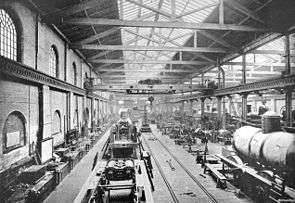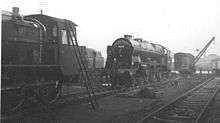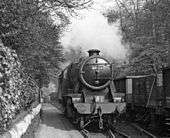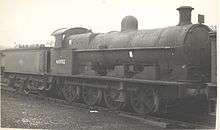Crewe Works
Crewe Works is a British railway engineering facility, built in 1840 by the Grand Junction Railway. It is located in the town of Crewe, in Cheshire. It is currently owned by Bombardier Transportation.

The railway also built 200 cottages, establishing a new community in what had been the rural township of Monks Coppenhall. Among the first workers to arrive were those from the old works at Edge Hill, producing an increase in the town's population by some 800 men, women and children.
History
Grand Junction Railway
The first locomotive built at Crewe went into service in 1843. By 1846, the demand for space was such that wagon building was moved, first to Edge Hill and Manchester, then to a new works at Earlestown. By 1848, the works employed over 1,000 producing one locomotive a week.
London and North Western Railway
In 1845, the Liverpool and Manchester Railway was merged with the Grand Junction. These, in turn, merged in 1846, with the London and Birmingham Railway and the Manchester and Birmingham Railway to form the London and North Western Railway (LNWR). All four had their own workshops but, in time, locomotive building was concentrated at Crewe.
In 1857, John Ramsbottom became Locomotive Superintendent. He had previously invented the first reliable safety valve and the scoop for picking up water from troughs between the tracks. He went on to improve the precision and interchangeability of tools and components.
In 1862, locomotive work was transferred from Wolverton. Wolverton became the carriage works, while wagon building was concentrated at Earlestown.
In 1853, Crewe had begun to make its own wrought iron and roll its own rails, and in 1864 installed a Bessemer converter for manufacturing steel. In 1868 it became the first place to use open-hearth furnaces on an industrial scale. It also built its own brickworks. Later the works was fitted with two electric arc furnaces.
Production increased steadily and, with the sale to the Lancashire and Yorkshire Railway of ten 2-4-0 and eighty six 0-6-0 locomotives, privately owned manufacturers took out an injunction in 1876 to restrain the railway from producing anything but its own needs. This remained in force until British Rail Engineering Limited was established in 1969.
London Midland and Scottish Railway

When the LNWR became part of the London, Midland and Scottish Railway (LMS) in 1923, its passenger locomotives were eclipsed by those of the former Midland Railway, which offered light, fast and frequent services. As traffic density increased, there was a need for longer trains and more powerful locomotives to haul them. In 1932, William Stanier became Chief Mechanical Engineer and set out to rationalise production. Since Crewe had experience with heavier locomotives and had its own steel making facilities, he chose it as his main production location.
There followed the Princesses and Duchesses, along with the Jubilees and the "Black Fives". Crewe produced all the new boilers for the LMS, and all heavy drop stampings and forgings. It also produced most of the heavy steel components for the track and other structures.
During World War II, Crewe produced over 150 Covenanter tanks for the army.

British Railways

No. 48932, built at Crewe in 1902 as a Webb Class B four-cylinder loco, was later rebuilt to two-cylinder status. Buxton shed August 1960.
After British Railways (BR) was formed in 1948, Robert Riddles introduced the BR standard classes, and Crewe built Britannia and Clan mixed traffic engines and some of the Class 9 freight locomotives. The last steam locomotive built at Crewe, Class 9 number 92250, was completed in December 1958. Crewe Works built 7,331 steam locomotives.[1]
Diesel production commenced, with D5030 the first main line example completed in 1959.[2] The final diesel locomotives built at Crewe Works were the Class 56 with the last completed in 1984, while the final class of electric locomotives were the Class 91 with the last completed in 1991.[3]
Privatisation
Much of the site at Crewe was cleared in a major redevelopment in the mid 1980s.
Crewe Works became a part of British Rail Engineering Limited when the former BR Workshops were set up as a separate business in 1969 and was privatised in 1989. This company was soon sold to ASEA Brown-Boveri, which merged with Daimler Benz in 1996 to form Adtranz. Adtranz was itself taken over by Bombardier in 2001.[4]
Today
At its height, Crewe Works employed over 20,000 people; in 2005 fewer than 1,000 remained on site, with a further 270 redundancies announced in November of that year and more cutbacks or even closure possible. Current work is largely focused on general maintenance and the inspection of seriously damaged stock. Much of the site once occupied by the works has been sold off and is now occupied by a supermarket, leisure park and a large new health centre.
Internal railway
From 1862 until 1932, the works was served by an internal narrow gauge tramway, the Crewe Works Railway.
| Access to Crewe Works[5] (Present) | |||||||||||||||||||||||||||||||||||||||||||||||||||||||||||||||||||||||||||||||||||||||||||||||||||||||||||||||||||||||||||||||||
|---|---|---|---|---|---|---|---|---|---|---|---|---|---|---|---|---|---|---|---|---|---|---|---|---|---|---|---|---|---|---|---|---|---|---|---|---|---|---|---|---|---|---|---|---|---|---|---|---|---|---|---|---|---|---|---|---|---|---|---|---|---|---|---|---|---|---|---|---|---|---|---|---|---|---|---|---|---|---|---|---|---|---|---|---|---|---|---|---|---|---|---|---|---|---|---|---|---|---|---|---|---|---|---|---|---|---|---|---|---|---|---|---|---|---|---|---|---|---|---|---|---|---|---|---|---|---|---|---|---|
| |||||||||||||||||||||||||||||||||||||||||||||||||||||||||||||||||||||||||||||||||||||||||||||||||||||||||||||||||||||||||||||||||
In fiction
In The Railway Series, as well as Thomas and Friends, Henry the Green Engine underwent a rebuild there after he crashed into a goods train while pulling the Flying Kipper.
Locomotive production
Under the London and North Western Railway, Crewe Works produced many famous locomotives: the Webb 2-4-0 Jumbo class and the compounds, the Whale Experiment and Precursor classes, and the Bowen-Cooke Claughtons. In particular, Whale's 1912 superheated G1 Class 0-8-0 developed from a locomotive introduced by Webb in 1892, lasted, in many cases until 1964, near the end of steam in 1968.
Under the London, Midland and Scottish Railway, the works was especially noted for Sir William Stanier's locomotives and in particular the 'Jubilee' 4-6-0s, the Class 5 mixed traffic 4-6-0s and the 'Princess Royal' and 'Princess Coronation' 4-6-2s.
Under British Railways, the works built many notable steam designs including the Britannia 4-6-2s and the Franco-Crosti boilered Class 9 freight locomotives.
See also
References
- Last Steam Locomotive from Crewe Works Railway Gazette 26 December 1958 page 762
- Crewe Works Builds Its First Main-Line Diesel-Electric Locomotive Railway Gazette 26 June 1959
- The Making of Crewe and What Made Crewe The Railway Magazine issue 1254 October 2005 pages 14-23
- Bombardier cleared to buy Adtranz Railway Gazette International May 2001
- from Google Earth/Google Maps
- Evans, Martin (1966). Inverness to Crewe: The British 4-6-0 Locomotive. UK: Model Aeronautical Press.
- Larkin, E.J.; Larkin, J.G. (1988). The Railway Workshops of Britain 1823-1986. London: Macmillan Press. ISBN 0-333-39431-3.
- Reed, Brian (1982). Crewe Locomotive Works and its Men. David and Charles. ISBN 0-7153-8228-4.
- Simmons, J. (1986). The Railway in Town and Country 1830-1914. Newton Abbott: David and Charles. ISBN 0-7153-8699-9.
- Talbot, E.; Taylor, C. (2005). The Crewe Works Narrow Gauge System (2nd ed.). Derby: The London & North Western Railway Society. ISBN 0-9546951-1-9.
Further reading
- Mitchell, Vic; Smith, Keith (2012). Stafford to Chester. West Sussex: Middleton Press. figs. 76-80. ISBN 9781908174345. OCLC 830024480.CS1 maint: ref=harv (link)
- Kelly, Peter (December 1982 – January 1982). "This is Crewe". Rail Enthusiast. EMAP National Publications. pp. 16–19. ISSN 0262-561X. OCLC 49957965.